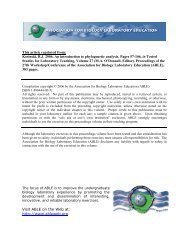New Light on Phototaxis and Phototropism - Association for Biology ...
New Light on Phototaxis and Phototropism - Association for Biology ...
New Light on Phototaxis and Phototropism - Association for Biology ...
You also want an ePaper? Increase the reach of your titles
YUMPU automatically turns print PDFs into web optimized ePapers that Google loves.
Volume 25: Mini Workshops 399<br />
absorbing photopigment is a protein-complex called rhodopsin. Rhodopsin molecules may differ<br />
with respect to the peak wavelength of light that they preferentially absorb. The presence of more<br />
than <strong>on</strong>e type of rhodopsin in the photoreceptor cells of an animal is required <strong>for</strong> the capability of<br />
color visi<strong>on</strong> - - a capability that some invertebrates have <strong>and</strong> others do not. Photoreceptor cells of<br />
animals may or may not be organized into structures that are recognizable as eyes. For example, in<br />
some animals (such as earthworms), no eyes are apparent but these organisms still detect light using<br />
photoreceptor cells that are diffusely scattered in the skin. <str<strong>on</strong>g>Light</str<strong>on</strong>g>-absorbing photopigments are also<br />
found in plants <strong>and</strong> these serve various functi<strong>on</strong>s. Some plant photopigments, called photosynthetic<br />
pigments (e.g., chlorophyll <strong>and</strong> carotenoid), functi<strong>on</strong> in photosynthesis. Other plant photopigments,<br />
called developmental pigments (e.g., phytochrome <strong>and</strong> cryptochrome), functi<strong>on</strong> in c<strong>on</strong>trolling plant<br />
growth <strong>and</strong> development. As in the photopigments of animals, plant photopigments also differ with<br />
respect to the wavelength of light that is preferentially absorbed [see Attridge, 1990; Salisbury <strong>and</strong><br />
Ross, 1992].<br />
Figure 1. Anatomy of an LED lamp.<br />
<strong>Phototaxis</strong> is a directed movement of a freely moving organism in relati<strong>on</strong> to the directi<strong>on</strong> of<br />
incident light in its envir<strong>on</strong>ment. <strong>Phototaxis</strong> is said to be “positive” when an organism moves<br />
toward the light source or “negative” when an organism moves away from the light source. In<br />
general, an animal’s phototaxic movement serves to bring it into a more favorable relati<strong>on</strong>ship with<br />
its envir<strong>on</strong>ment (e.g., improved nutriti<strong>on</strong>al status or protecti<strong>on</strong>). Examples of positive phototaxis<br />
occur in many zooplankt<strong>on</strong>ic crustacea, such as daphnids <strong>and</strong> copepods. The term, “heliotaxis,” is<br />
sometimes used to refer to the directed movement of an animal toward or away from sunlight.<br />
Photokinesis is the change of an organism’s speed of movement or frequency of movements in<br />
relati<strong>on</strong> to the level of light energy (light intensity) that falls <strong>on</strong> the organism per unit time.<br />
Photokinesis is independent of the directi<strong>on</strong> of light. Examples include certain insect larvae (some<br />
beetles <strong>and</strong> fruit flies) that increase their rate of movement in relati<strong>on</strong> to an overall increase in the<br />
intensity of ambient light. It is possible <strong>for</strong> an organism’s resp<strong>on</strong>se to light to involve a combinati<strong>on</strong><br />
of both phototaxis <strong>and</strong> photokinesis.<br />
Associati<strong>on</strong> <strong>for</strong> <strong>Biology</strong> Laboratory Educati<strong>on</strong> (ABLE) ~ http://www.zoo.utor<strong>on</strong>to.ca/able
















